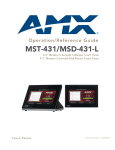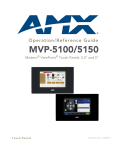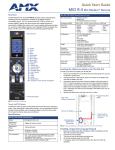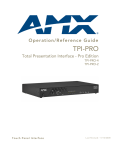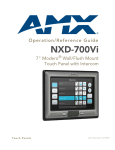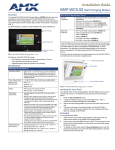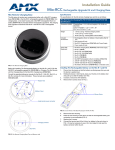Download AMX MVP-TDS
Transcript
Operation/Reference Guide MVP-TDS Table Docking Station for MVP-7500/8400 Modero® ViewPoint® Wireless Touch Panels Touch Panels & Accessories Last Revised: 5/19/2009 AMX Limited Warranty and Disclaimer AMX warrants its products to be free of defects in material and workmanship under normal use for three (3) years from the date of purchase from AMX, with the following exceptions: • Electroluminescent and LCD Control Panels are warranted for three (3) years, except for the display and touch overlay components that are warranted for a period of one (1) year. • Disk drive mechanisms, pan/tilt heads, power supplies, and MX Series products are warranted for a period of one (1) year. • AMX Lighting products are guaranteed to switch on and off any load that is properly connected to our lighting products, as long as the AMX Lighting products are under warranty. AMX does guarantee the control of dimmable loads that are properly connected to our lighting products. The dimming performance or quality cannot be guaranteed due to the random combinations of dimmers, lamps and ballasts or transformers. • Unless otherwise specified, OEM and custom products are warranted for a period of one (1) year. • AMX Software is warranted for a period of ninety (90) days. • Batteries and incandescent lamps are not covered under the warranty. This warranty extends only to products purchased directly from AMX or an Authorized AMX Dealer. All products returned to AMX require a Return Material Authorization (RMA) number. The RMA number is obtained from the AMX RMA Department. The RMA number must be clearly marked on the outside of each box. The RMA is valid for a 30-day period. After the 30-day period the RMA will be cancelled. Any shipments received not consistent with the RMA, or after the RMA is cancelled, will be refused. AMX is not responsible for products returned without a valid RMA number. AMX is not liable for any damages caused by its products or for the failure of its products to perform. This includes any lost profits, lost savings, incidental damages, or consequential damages. AMX is not liable for any claim made by a third party or by an AMX Dealer for a third party. This limitation of liability applies whether damages are sought, or a claim is made, under this warranty or as a tort claim (including negligence and strict product liability), a contract claim, or any other claim. This limitation of liability cannot be waived or amended by any person. This limitation of liability will be effective even if AMX or an authorized representative of AMX has been advised of the possibility of any such damages. This limitation of liability, however, will not apply to claims for personal injury. Some states do not allow a limitation of how long an implied warranty last. Some states do not allow the limitation or exclusion of incidental or consequential damages for consumer products. In such states, the limitation or exclusion of the Limited Warranty may not apply. This Limited Warranty gives the owner specific legal rights. The owner may also have other rights that vary from state to state. The owner is advised to consult applicable state laws for full determination of rights. EXCEPT AS EXPRESSLY SET FORTH IN THIS WARRANTY, AMX MAKES NO OTHER WARRANTIES, EXPRESSED OR IMPLIED, INCLUDING ANY IMPLIED WARRANTIES OF MERCHANTABILITY OR FITNESS FOR A PARTICULAR PURPOSE. AMX EXPRESSLY DISCLAIMS ALL WARRANTIES NOT STATED IN THIS LIMITED WARRANTY. ANY IMPLIED WARRANTIES THAT MAY BE IMPOSED BY LAW ARE LIMITED TO THE TERMS OF THIS LIMITED WARRANTY. FCC Information This device complies with Part 15 of the FCC Rules. Operation is subject to the following two conditions: (1) this device may not cause harmful interference, and (2) this device must accept any interference received; including interference that may cause undesired operation. Federal Communications Commission (FCC) Statement This equipment has been tested and found to comply with the limits for a Class B digital device, pursuant to Part 15 of the FCC rules. These limits are designed to provide reasonable protection against harmful interference in a residential installation. This equipment generates, uses and can radiate radio frequency energy, and, if not installed and used in accordance with the instructions, may cause harmful interference to radio communications. However, there is no guarantee that interference will not occur in a particular installation. If this equipment does cause harmful interference to radio or television reception, which can be determined by turning the equipment off and on, the user is encouraged to try to correct the interference by one or more of the following measures: • Reorient or relocate the receiving antenna. • Increase the separation between the equipment and receiver. • Connect the equipment into an outlet on a circuit different from that to which the receiver is connected. • Consult the dealer or an experienced radio/TV technician for help. FCC RF Radiation Exposure Statement This transmitter must not be co-located or operating in conjunction with any other antenna or transmitter. This equipment complies with FCC RF radiation exposure limits set forth for an uncontrolled environment. This equipment should be installed an operated with a minimum distance of 20 centimeters between the radiator and your body. Table of Contents Table of Contents MVP-TDS Table Top Docking Station .................................................................1 Overview .................................................................................................................. 1 Specifications ................................................................................................................. 1 MVP-TDS docking station connectors ............................................................................. 2 MVP-TDS LED Indicators ................................................................................................. 3 Installation ................................................................................................................ 3 Interface Connector Pins and Functions .......................................................................... 3 Connecting a Power Supply...................................................................................... 3 Powering the MVP-TDS................................................................................................... 3 Connecting a USB Keyboard and Mouse to the MVP-TDS........................................ 4 Securing an MVP Panel to an MVP-TDS .................................................................... 5 Removing an MVP Panel from an MVP-TDS.............................................................. 6 Unsecured MVP removal from an MVP-TDS.................................................................... 6 Secured MVP removal from an MVP-TDS........................................................................ 6 Undock-<USER> String ................................................................................................... 6 Installing and Charging Batteries in the Docking Stations ........................................ 6 Installing an MVP-BP Battery into an MVP-TDS............................................................... 7 Upgrading the Docking Station Firmware ..........................................................9 Step 1: Prepare the Docking Station for firmware transfer via USB................................ 9 Step 2: Upgrade the Docking Station firmware via USB ............................................... 10 MVP-TDS Table Docking Station for MVP Panels i Table of Contents ii MVP-TDS Table Docking Station for MVP Panels MVP-TDS Table Top Docking Station MVP-TDS Table Top Docking Station Overview The MVP-TDS Table Top Docking Station (FG5965-10) extends the functionality of the MVP panels when resting on a flat surface. The MVP-TDS recharges the panel’s batteries while maintaining continuous control of integrated technology (FIG. 1). The MVP-TDS utilizes an locking mechanism that allows you to adjust the vertical viewing angle, and uses an electromagnet to secure the panel. The Security Release pushbutton releases the MVP panel from the TDS. Electromagnet support cradle alignment guide pins interface connector pins Battery Status LED Communication LED Security Release pushbutton FIG. 1 MVP-TDS Docking Station components One or two MVP-BP batteries can be recharged from either of the two rear compartments on the MVP-TDS (or from within a docked MVP panel). Attach a keyboard or mouse using the docking station's rear USB ports. This connection facilitates surfing the Web via the G4 Computer Control application. A password can be enabled via the Protected Password page. This feature requires that the code must be entered on the panel (via the on-screen security/Password keypad) before it can be removed from the docking station. The following table lists the specifications for the MVP-TDS Table Top Docking Station. Specifications MVP-TDS Specifications Dimensions (HWD): • Fully raised: 7.49" x 7.00" x 9.83" (19.02 cm x 17.78 cm x 25.00 cm) • Fully lowered: 4.27" x 7.00" x 9.83" (10.80 cm x 17.78 cm x 25.00 cm) • Fully raised with panel installed: 9.00” x 7.00” x 9.83” (22.86 cm x 17.78 cm x 25.00 cm) MVP-TDS Table Docking Station for MVP Panels 1 MVP-TDS Table Top Docking Station MVP-TDS Specifications (Cont.) Power Requirements: • Stand-alone with no batteries: 0.1 A @ 12 VDC • Stand-alone charging two batteries: 2.1 A @ 12 VDC • With no batteries and charging a connected MVP panel’s two internal batteries: 3.3 A @ 12 VDC • With two batteries and charging a connected MVP panel’s two internal batteries: 3.3 A @ 12 VDC Weight: • Stand-alone: 3.38 lbs (1.53 kg) • With two batteries: 4.18 lbs (1.90 kg) Charging Features: • Two-Bays: Simultaneous Charging • Charge time for two depleted batteries ~ 5 hours Front Panel Components: • Electromagnet • MVP Interface Connector Pins: Provides both communication and power between the MVP and the MVP-TDS. • MVP Support Cradle: This cradle supports a MVP panel and allows a user to angle the MVP LCD. • LEDs (blue): - Left LED indicates battery status in either the MVP-TDS or MVP - Right LED indicates communication between the MVP-TDS and MVP • Security Release pushbutton: Toggles an on-screen keypad for entering a security code (password). If security is enabled, a valid password must be entered before the MVP can be removed from the TDS. Rear Panel Components: • Battery Compartment: Houses up to two MVP-BP batteries. • USB Connectors: Two type A USB ports connect an external keyboard and mouse device for use with the G4 Computer Control application. • Power Connector: 2.1 mm barrel-style power jack - connects to a PS4.4 power supply connector. Operating/Storage Environments: • Operating Temperature: 0° C (32° F) to 40° C (104° F) • Operating Humidity: 20% - 85% RH • Storage Temperature: -20° C (-4° F) to 60° C (140° F) • Storage Humidity: 5% - 85% RH MVP-TDS docking station connectors FIG. 2 shows the layout of the connectors on the rear of the MVP-TDS. Keyboard/Mouse USB Connectors Battery Compartment 1 Battery Compartment 2 12VDC KEYBOARD/ MOUSE KEYBOARD/ MOUSE PWR PWR connector (for use with PS4.4 power supply) FIG. 2 Connector layout on the rear of the MVP-TDS 2 MVP-TDS Table Docking Station for MVP Panels MVP-TDS Table Top Docking Station MVP-TDS LED Indicators The two LED indicators indicate the battery and communication status: LED Pattern Indicators for the MVP-TDS LED Left - Battery Status TDS only Right - Comm. Status MVP in Cradle Solid Bright TDS batteries are fully charged MVP batteries are fully charged MVP panel is docked and communicating Flashing Bright (Slow) TDS batteries are charging MVP batteries are charging N/A Flashing Bright (Fast) N/A N/A MVP panel is docked but not communicating Solid Dim TDS receiving power but contains no batteries in cradle No batteries within the MVP MVP panel is NOT docked and NOT communicating Installation Interface Connector Pins and Functions FIG. 3 gives the pin numbering and function information for the docking stations 1 - Data - Panel Detect IN 2 - Ground 3 - not used 4 - Ground 5 - not used 6 - Ground 7 - not used 8 - not used 9 - not used 10 - DC Power 11 - Data - Receive 12 - DC Power 13 - Data - Transmit 14 - DC Power 15 - Data - USB Device D16 - Data - Cradle Detect 17 - Data - USB Device D+ 18 - Data - Panel Detect OUT 2 1 18 17 FIG. 3 MVP-TDS Connector Pin locations and Pinout function Connecting a Power Supply The MVP-TDS uses a PS4.4 power supply (included with the MVP) to indirectly provide power to the MVP panel, while charging internal batteries. Static electricity can damage electronic circuitry. Before touching the unit, discharge any accumulated static electricity from your body by touching a grounded metal object. Powering the MVP-TDS 1. Connect the terminal end of the PS4.4 power supply to the rear PWR connector on the TDS. 2. Provide power to the MVP-TDS by connecting the PS4.4 AC power cord to an external power source. MVP-TDS Table Docking Station for MVP Panels 3 MVP-TDS Table Top Docking Station Once MVP batteries are fully charged, the MVP-TDS begins charging MVP-BP batteries inserted within its rear battery compartments. Initially, both blue LEDs illuminate and remain dim (indicating that the power is being supplied to the MVP-TDS). Connecting a USB Keyboard and Mouse to the MVP-TDS The MVP-TDS can have two USB input devices (keyboard and mouse) connected for use on the MVP panel’s different firmware and TPD4 panel pages. These input devices can consist of a keyboard and mouse. USB input devices are detected by the docking stations only after they are connected and then power is applied. 1. Remove the power connector from the docking station. 2. Insert the USB connectors of the peripheral input devices, into the appropriate USB connector on the docking station. 3. Reconnect the terminal power connector to the docking station and apply power. 4. Install the MVP panel onto the docking station. 5. Navigate to the Protected Setup page on the MVP panel and press the Reboot button to restart the panel. This step allows the MVP panel to detect the USB input devices signals being sent through the connected docking station. The MVP does not recognize the keyboard and/or mouse (connected to the docking station) until after the MVP itself has been rebooted. It does not matter if the MVP is on the docking station at the time the USB devices are plugged in or not. The reboot of the panel has to occur after the MVP is properly connected and communicating with the docking station. In addition, if the MVP is removed from the docking station, the panel will not recognize the keyboard and/or mouse after it is put back on the docking station - the MVP will have to be rebooted again. 6. After the panel splash-screen disappears: If a USB mouse has been connected, a mouse cursor appears on the panel screen and its location corresponds to the mouse cursor position sent by the external USB mouse. If a USB keyboard has been connected, only on-screen keyboards and keypads will reflect any external keystrokes sent from the external USB keyboard. To be detected by the docking station, USB input devices (keyboard / mouse) must be plugged into the docking station before it is powered-up. The docking station will not detect USB input devices until the unit cycles power. 4 MVP-TDS Table Docking Station for MVP Panels MVP-TDS Table Top Docking Station Securing an MVP Panel to an MVP-TDS The MVP will not be able to communicate with or receive power from the MVP-TDS without a proper connection. 1. Place the MVP-TDS on a flat and level surface. 2. Provide power to the MVP-TDS (refer to the Powering the MVP-TDS section on page 3). 3. Place the MVP on the support cradle so that the alignment pins on the TDS fit into the matching holes on the bottom of the MVP. 4. Once proper alignment is verified, gently angle back the MVP until the rear of the panel makes contact with the electromagnet. Allow one second to activate the electromagnet. When the MVP is properly docked, the following message is displayed on the panel (FIG. 4). On-screen Docking message Docking Status button (illuminates to also give an indication that the panel is properly docked) FIG. 4 System message - panel is properly docked Proper docking and communication can be verified via the on-screen system message, or the illuminated Docking Status button on the Protect Setup page, or the right LED on the docking station. If the MVP is docked properly and communicating, the right LED on the MVP-TDS will remain brightly illuminated. Refer to the LED Pattern Indicators for the MVP-TDS table on page 3 for more information. If the panel is not securely attached, the electromagnet on the TDS will not be activated, and the panel could fall forward and be damaged. MVP-TDS Table Docking Station for MVP Panels 5 MVP-TDS Table Top Docking Station Removing an MVP Panel from an MVP-TDS The MVP security feature requires the entry of a security code (password) entered via an on-screen keypad. This password is entered within the MVP’s Password Setup page. Refer to the MVP-7500/8400 Operation/Reference Guide (available online at www.amx.com) for more information on setting up a User Access username and password. Unsecured MVP removal from an MVP-TDS 1. Press and hold the security release pushbutton. Allow one second for the electromagnet to turn off. 2. Gently angle the MVP forward. 3. Lift the panel off the alignment guide pins and remove it from the support cradle. Secured MVP removal from an MVP-TDS 1. Press and hold the security release pushbutton until the on-screen keypad appears on the MVP. 2. Enter the security release password. 3. Press Done when finished. Allow the MVP-TDS one second to process the release request and turn off the electromagnet. 4. Angle the MVP forward. 5. Lift the panel off the alignment guide pins and remove it from the support cradle. Undock-<USER> String When the MVP is removed from the docking station (undocked), the undock-<user> string is sent to the NetLinx Master. If the panel has no information within the User Access Passwords list, ’none’ is sent as a user. If the undock button on the Protected Setup page is used, ’setup’ is sent as a user. This string can be disabled from within the firmware setup pages. When the MVP is placed on a docking station (docked), the dock string is sent to a target Master. This string can be disabled from within the firmware setup pages. Installing and Charging Batteries in the Docking Stations The MVP-TDS and MVP-WDS Docking Stations recharge any installed MVP-BP batteries and provide USB input device interaction to the connected MVP panel through the two USB connectors on the docking stations. Both docking stations are firmware upgradeable and provide battery feedback information to the MVP (battery status information is accessible through the MVP Batteries page). Before using these docking stations, verify they have been installed with the latest firmware. Refer to Refer to the MVP-7500/8400 Operation/Reference Guide (available online at www.amx.com) for more information. Once an MVP is connected to a docking station, charging is first applied to any MVP-BP batteries found within the panel’s rear battery compartment and then to any batteries inserted within the docking station. 6 MVP-TDS Table Docking Station for MVP Panels MVP-TDS Table Top Docking Station Installing an MVP-BP Battery into an MVP-TDS The MVP-TDS connects directly to a PSN4.4 power supply and provides both power and communication to docked MVP panel. The MVP-TDS can charge batteries in its own battery compartments, as well as those within the MVP panel. 1. Raise the rear connector cover to expose the battery compartments and connectors. 2. Slide the MVP-BP into the battery compartment (AMX label up) until the connector makes contact with the battery pins at the end of the battery slot. 3. Repeat these steps for any additional MVP-BP batteries. 4. The status of the connected batteries are reflected on the panel’s Batteries page and the LEDs on the docking station. A completely discharged battery requires one full charge cycle from within battery compartment #1. Refer to FIG. 2 on page 2 for locations. MVP-TDS Table Docking Station for MVP Panels 7 MVP-TDS Table Top Docking Station 8 MVP-TDS Table Docking Station for MVP Panels Upgrading the Docking Station Firmware Upgrading the Docking Station Firmware The following accessory devices are firmware upgradeable: MVP-TDS Table Top Docking Station (FG5965-10) MVP-WDS Wall/Flush Mount Docking Station - Black (FG5965-11) MVP-WDS Wall/Flush Mount Docking Station - Silver (FG5965-21) This device is not given a unique device number which would ordinarily appear within the Online Tree tab of NetLinx Studio. It appears as a battery base below the target panel which it is a part of as seen below in FIG. 1. Target Panel Device # TDS/WDS (station version) NetLinx Studio Online Tree tab Accessory’s corresponding firmware page FIG. 1 Location of Firmware version information within NetLinx Studio The only way to upgrade the firmware of these accessory items is to send the accessory’s firmware through a target panel. Its this panel’s device number which is entered within the Send to NetLinx Device transfer dialog in Studio. Step 1: Prepare the Docking Station for firmware transfer via USB Before beginning with this section: Verify the MVP is securely attached to the docking station and communicating properly. Verify that the panel is communicating from the mini-USB port to the Virtual NetLinx Master (VNM). 1. Configure the NetLinx Master for IP communication. Refer to the MVP-7500/8400 Operation/ Reference Guide (available online at www.amx.com) for information. 2. After the panel powers-up, press and hold the two lower buttons on both sides of the display for 3 seconds to continue with the setup process and proceed to the Setup page. 3. Press the Batteries button to open the Batteries page (FIG. 2). MVP-TDS Table Docking Station for MVP Panels 9 Upgrading the Docking Station Firmware Displays the current docking station firmware version FIG. 2 Batteries page The docking station firmware is shown on the right of the Batteries page. Verify you have downloaded the latest firmware file from www.amx.com and then save the Kit file to your computer. Step 2: Upgrade the Docking Station firmware via USB 1. Configure the panel for a USB Connection Type. 2. Prepare NetLinx Studio for communication to the panel via a Virtual Master. Refer to the MVP-7500/8400 Operation/Reference Guide (available online at www.amx.com) for information on configuring communications on the panel. 3. After the Communication Verification dialog window verifies active communication between the Virtual Master and the panel, click the OnLine Tree tab in the Workspace window to view the devices on the Virtual System. The default System value is one. 4. Right-click on the System entry and select Refresh System to re-populate the list. Verify the panel appears in the OnLine Tree tab of the Workspace window. The default Modero panel value is 10001. 5. Locate the latest firmware file from the www.amx.com > Tech Center > Downloadable Files > Firmware Files > Modero Panels firmware (MVP Docking Stations: MVP-TDS/WDS) section of the website. 6. Click on the desired Kit file link and after you’ve accepted the Licensing Agreement, verify you have downloaded the Docking Station Kit file to a known location. 7. Select Tools > Firmware Transfers > Send to NetLinx Device from the Main menu to open the Send to NetLinx Device dialog (FIG. 3). Verify the panel’s System and Device number values match those values listed within the System folder in the OnLine Tree tab of the Workspace window. 8. Select the docking station’s Kit file (ending in VXX.kit) from the Files section (FIG. 3). 9. Enter the Device number associated with the panel and the System number associated with the Master (listed in the OnLine Tree tab of the Workspace window). The Port field is greyed-out. 10 MVP-TDS Table Docking Station for MVP Panels Upgrading the Docking Station Firmware Selected Docking Station Firmware file Description field for selected Kit file Firmware download status Device and System values must match the System and Device values listed in the Project Navigator window FIG. 3 Send to NetLinx Device dialog (showing docking station firmware update via USB) Firmware upgrades can not be done directly to the docking station but must be routed through the MVP panel. 10. Click the Reboot Device checkbox. This causes the touch panel to reboot after the firmware update process is complete. The reboot of the panel can take up 30 seconds after the firmware process has finished. 11. Click Send to begin the transfer. The file transfer progress is indicated on the bottom-right of the dialog. 12. As the panel is rebooting, temporarily unplug the USB connector on the panel until the panel has completely restarted. 13. Once the first panel page has been displayed, reconnect the USB connector to the panel. 14. Right-click the associated System number and select Refresh System. This causes a refresh of all project systems, establishes a new connection to the Master, and populates the System list with devices on your particular system. 15. After the panel powers-up, press and hold the two lower buttons on both sides of the display for 3 seconds to continue with the setup process and proceed to the Setup page. 16. Press the Batteries button (located on the lower-left) to open the Batteries page and confirm the new firmware does not read 0.00. If the Base Version field displays 0.00, this means there was an error in the firmware upload process. Re-install the base firmware and re-confirm that the new base version no longer reads 0.00. MVP-TDS Table Docking Station for MVP Panels 11 Upgrading the Docking Station Firmware Although firmware upgrades can be done over wireless Ethernet; it is recommended that firmware KIT files be transferred over a direct USB connection and only when the panel is connected to a power supply. If battery power or wireless connection fails during a firmware upgrade, the panel flash file system may become corrupted. 12 MVP-TDS Table Docking Station for MVP Panels MVP-TDS Table Docking Station MVP-TDS Table Docking Station for MVP Panels 13 AMX. All rights reserved. AMX and the AMX logo are registered trademarks of AMX. AMX reserves the right to alter specifications without notice at any time. ©2009 5/09 It’s Your World - Take Control™ 3000 RESEARCH DRIVE, RICHARDSON, TX 75082 USA • 800.222.0193 • 469.624.8000 • 469-624-7153 fax • 800.932.6993 technical support • www.amx.com























